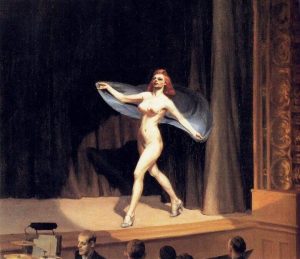In “Girlie Show,” the setting of the story is never stated, but the painting used as the ekphrasis foundation was created in 1941 and based on the description of Pauline’s clothing on page 5 (dress, stockings, slip, brassiere, step-ins), it would be logical to assume that the setting is the same period. The 1940’s were a time when women were expected to strictly adhere to the role of the Good and Loyal Wife who obeyed their husband without complaint and provided ‘service with a smile.’ The protagonist, Pauline, spends 90% of the story on the receiving end of her husband’s emotional, physical, and sexual abuse. There are multiple signs that he is seeing other women (shoes that don’t fit her, staying out constantly, drawings that certainly do not look like her), yet Pauline continually chooses to ignore the evidence up until pages 12-13, when she happens to spot him out and about and she follows him to a theater. It is also on page 13 that Pauline meets her first true ally at the theater.
 Mae approaches Pauline in a cordial manner and confirms that her husband is indeed a regular at the theater. Mae drives off a catcaller watching Pauline, then takes her backstage to prevent any similar happenings, at the same time protecting her from the remarks of the other performers they pass by. In Mae’s dressing room, Pauline nearly cries until she sees gifts from her husband to Mae. She no longer wants to cry; instead she feels rage bubble up inside of her. Mae helps Pauline transform into a dancer and gives her a brief time to perform onstage, to enact revenge on her unfaithful husband. The plan works and he is taken outside and beaten to a pulp by the bouncer, screaming blame at Pauline for his situation.
Mae approaches Pauline in a cordial manner and confirms that her husband is indeed a regular at the theater. Mae drives off a catcaller watching Pauline, then takes her backstage to prevent any similar happenings, at the same time protecting her from the remarks of the other performers they pass by. In Mae’s dressing room, Pauline nearly cries until she sees gifts from her husband to Mae. She no longer wants to cry; instead she feels rage bubble up inside of her. Mae helps Pauline transform into a dancer and gives her a brief time to perform onstage, to enact revenge on her unfaithful husband. The plan works and he is taken outside and beaten to a pulp by the bouncer, screaming blame at Pauline for his situation.
The automatic assumption in my mind while reading was that Pauline and Mae would have a catty, antagonistic relationship with each other upon the reveal about Pauline’s husband. I was pleasantly surprised and intrigued when they did not take that route. They instead established an immediate closeness. While they are together, Pauline recalls childhood memories that shine a more positive light on her life, like scarfing down forbidden candies with a female peer. It is incredibly apparent that Pauline feels far more comfortable with Mae than anyone else, namely by:
- Relaying the stolen candy story to Mae, despite never having told anyone before
- Noting Mae’s physical features
- Feeling bashful while Mae does her body makeup
- Outright flirting with each other
At the end of “Girlie Show,” after watching her husband be pummeled, Pauline returns to Mae’s dressing room, closes the door behind her, and, one would assume, furthers her already intimate relationship with Mae.
Pauline’s warranted rebellion and being around Mae was a breath of fresh air to walk through. More often than not, in fiction stories, there is a prominent aloneness for female protagonists. They must deal with personal struggles by themselves or at the least with a mother/sister figure to pat their back and offer reassurance. To witness women who barely know each other helping one another out purely out of sympathy or empathy is immeasurably gratifying. In our own world, women will help other women whether in small or large ways, whether by providing supplies in times of shortage (personal or familial) or taking information about unknown dates that they plan to go on or seeing someone who looks uncomfortable in a place/talking to someone and offering to accompany her. All of these establish unity between one another and a desire to protect the wellbeing of fellow women from all walks of life. I am so very glad that this was the path Megan Abbott took Pauline down.
I absolutely loved this take on the Girlie Show! Not only did Pauline’s husband cheat on her, but if she was seen talking to another man, he would slap her. I absolutely loved the ending too! I wish we had learned about what happened between Pauline and Mae and if she returned to the house with her husband. I agree that there is not a lot of fictional writing that shows a healthy relationship between two females, so I was happy that it wasn’t “the housemaker vs. the homewrecker.” Incredible story, and the way you summarized it was perfect!
The interaction between Pauline and Mae creates not only an interesting relationship between two unlikely characters, but it also causes Pauline to gain more confidence in herself and her looks. It can become commonplace for other women to compare themselves too much to others, and yet this story takes a different path by having Mae help Pauline gain a sense of pride in herself that was lacking beforehand. Very well-stated summary!